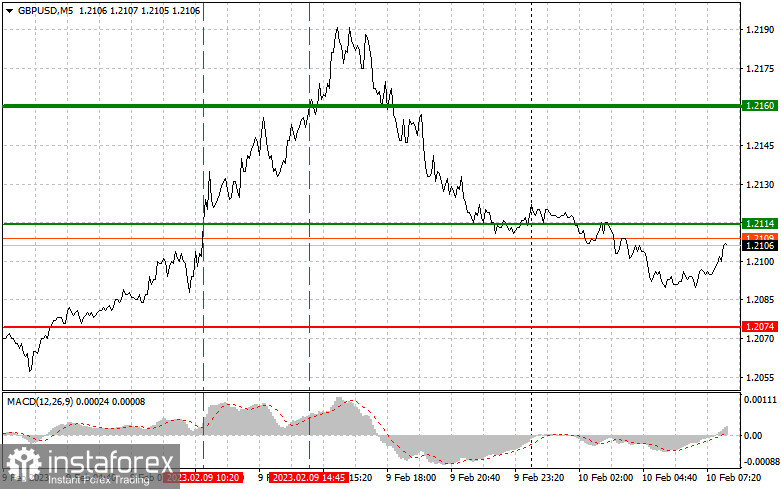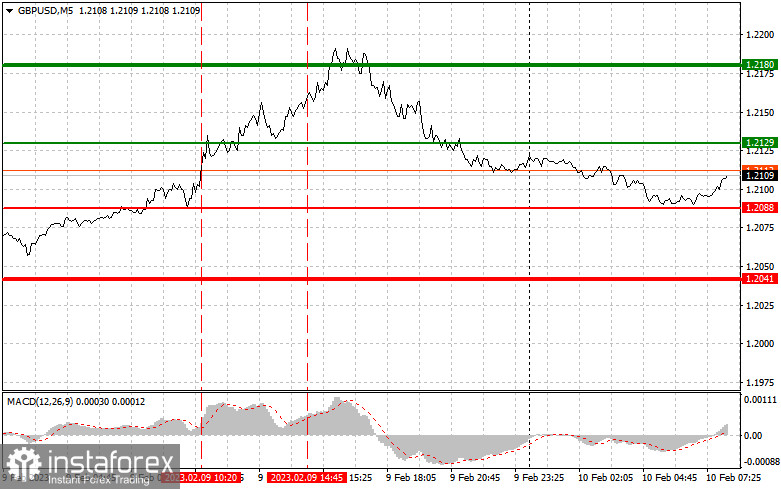GBP/USD overview of trades and trading tips
The price tested the 1.2114 level when the MACD indicator had already moved up far from the zero line which was supposed to limit the upside potential of the pound. That is why I decided to refrain from going long and was wrong about it. In the second half of the day, I sold the pound after a rebound from 1.2160 and managed to win back some of my losses as the downside movement never happened. All in all, it wasn't a perfect day.

Today can be a difficult day as well. The downbeat GDP data for the fourth quarter of 2022 will definitely weigh on the pound which may result in another sharp drop. Lower industrial production will also confirm a recession which the Bank of England is trying to avoid at all costs. It is also worth paying attention to what Huw Pill, the chief economist of the Bank of England, will say. His dovish comments may push the pound even lower. Later in the day, the US will release the Michigan consumer sentiment and inflation expectations reports. A higher reading will support the US dollar. The statement by FOMC member Christopher Waller may also give more confidence to USD bulls.
Buy signals
Scenario №1: it is possible to buy the pound today when the price hits the entry point of 1.2129 (a green line on the chart) with the upward target at 1.2180 (a thicker green line on the chart). I recommend closing buy positions at the level of 1.2180 and going short in the opposite direction, considering a retracement of 30-35 pips from this level. The pound may develop growth only if the UK GDP report turns out to be unexpectedly strong. Note! Before going long, make sure that the MACD indicator is located above the zero mark or has just started to rise from it.
Scenario №2: you can also buy the pound when the price reaches the level of 1.2088 but make sure that the MACD is holding in the oversold area. This will limit the downside potential of the pair and will initiate an upside reversal. In this case, the quote may rise to the levels of 1.2129 and 1.2180.
Sell signals
Scenario №1: selling the pound is possible today after a retest of the 1.2088 level (a red line on the chart) which may lead to a rapid decline in the pair. The key downward target for sellers will become the level of 1.2041 where I recommend closing sell positions and going long in the opposite direction, considering a retracement of 20-25 pips from this level. The pound will come under pressure if the economic data is weak and the BoE officials disappoint markets. Note! Before going short, make sure that the MACD indicator is located below the zero level or has just started to decline from it.
Scenario №2: you can also sell the pound when the price hits the 1.2129 level but make sure that the MACD has entered the overbought area. This will limit the upside potential of the price and lead to a downward reversal. In this case, the quote may move lower to the levels of 1.2088 and 1.2041.

On the chart:
The thin green line indicates the entry point for buying the instrument;
The thick green line indicates the estimated level for setting a Take Profit or closing trades manually as the pair is unlikely to move above this line;
The thin red line indicates the entry point for selling the instrument;
The thick red line indicates the estimated level for setting a Take Profit or closing trades manually as the pair is unlikely to move below this line;
When entering the market, it is essential to consider whether the MACD is located in the oversold or overbought area.
Important! Beginners on Forex should be very careful when making a decision to enter the market. It is recommended to stay out of the market ahead of important news releases to avoid sharp fluctuations of the price. If you decide to trade on the news, make sure you set stop-loss orders to minimize losses. Without setting a Stop Loss, you risk losing your entire deposit in no time, especially if you do not use money management and trade with large volumes.
Remember that you need to have a well-developed trading plan similar to the one above to be successful in trading. Spontaneous decision-making based on the current market situation is a losing strategy for an intraday trader.





















